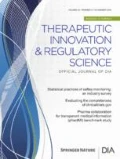Abstract
The nonparametric age-adjusted test proposed by Kodell and Ahn (1) for assessing doserelated trend with respect to the tumor incidence rate in animal experiments is extended from the case of multiple sacrifices to the case of a single (terminal) sacrifice. The tumor incidence rate is made identifiable for time intervals preceding the final time interval by assuming constant proportionality of the tumor prevalences in live and dead animals. Information on cause of death is not required. A Monte Carlo simulation study is conducted to assess size and power of the test.
Similar content being viewed by others
References
Kodell RL, Ahn H. Age-adjusted trend test for the tumor incidence rate. Biometrics. 1997.
McKnight B, Crowley J. Tests for differences in tumor incidence based on animal carcinogenesis experiments. J. Am Stat Assoc. 1984;79:639–648.
Peto R, Pike MC, Day NE, Gray RG, Lee PN, Parish S, Peto J, Richards S, Wahrendorf J. Guidelines for simple, sensitive significance tests for carcinogenic effects in long-term animal experiments. Annex to: Long-term and short-term screening assays for carcinogens: a critical appraisal. IARC Monographs, Supplement 2. Lyon, France: IARC;1980:311–426.
Hoel DG, Walburg HE. Statistical analysis of survival experiments. J Nat Cancer Inst. 1972;49:361–372.
Dewanji A, Kalbfleisch JD. Nonparametric methods for survival/sacrifice experiments. Biometrics. 1986;42:325–341.
Portier CJ, Dinse, GE. Semiparametric analysis of tumor incidence rates in survival/sacrifice experiments. Biometrics. 1987;43:107–114.
Malani HM, Van Ryzin J. Comparison of two treatments in animal carcinogenicity experiments. J Am Stat Assoc. 1988;83:1171–1177.
Williams PL, Portier CJ. Analytic expressions for maximum likelihood estimators in a nonparametric model of tumor incidence and death. Comm Stat—Theory Meth. 1992;21:711–732.
Malani HM, Lu Y. Animal carcinogenicity experiments with and without serial sacrifice. Comm Stat—Theory Meth. 1993;22:1557–1584.
Ahn H, Kodell RL. Estimation and testing of tumor incidence rates in experiments lacking cause-of-death data. Biometrical J. 1995;37:745–763.
Kodell RL, Ahn H. Nonparametric trend test for the cumulative tumor incidence rate. Comm Stat—Theory Meth. 1996;25:1677–1692.
Dinse GE. Constant risk differences in the analysis of animal tumorigenicity data. Biometrics. 1991;47:681–700.
Lindsey JC, Ryan LM. A comparison of continuous- and discrete-time three-state models for rodent tumorigenicity experiments. Environ Health Perspect. 1994;102 (Suppl. 1), 9–17.
IMSL. MATH/LIBRARY User’s Manual. FORTRAN Subroutines for Mathematical Applications. Houston, TX: IMSL, Inc., 1989.
Box MJ. A new method of constrained optimization and a comparison with other methods. Computer J. 1965;8:42–52.
Nelder JA, Mead R. A simplex method for function maximization. Computer J. 1965;7:308.
Richardson JA, Kuester JL. The Complex Method for constrained optimization (Algorithm 454). Comm ACM. 1973;16:487–489.
Bailer AJ, Portier CJ. Effects of treatment-induced mortality and tumor-induced mortality on tests for carcinogenicity in small samples. Biometrics. 1988;44:417–431.
Portier C, Hedges J, Hoel DG. Age-specific models of mortality and tumor onset for historical control animals in the National Toxicology Program’s carcinogenicity experiments. Cancer Res. 1986;46:4372–4378.
Dinse GE. A comparison of tumour incidence analyses applicable in single-sacrifice animal experiments. Stat Med. 1994;13:689–708.
Peto R, Peto J. Asymptotically efficient rank invariant test procedures (with discussion). J Roy Stat Soc A. 1972;135:185–207.
Boldebuck DH, Heimann G, Neuhaus G. Analysing carcinogenicity assays without cause of death information. Drug InfJ. 1997;31.
Mantel N. Evaluation of survival data and two new rank-order statistics arising in its consideration. Cancer Chemo Reports. 1966;50:163–170.
Tarone RE. Tests for trend in life table analysis. Biometrika. 1975;62:679–682.
Author information
Authors and Affiliations
Rights and permissions
About this article
Cite this article
Kodell, R.L., Pearce, B.A., Turturro, A. et al. An Age-Adjusted Trend Test for the Tumor Incidence Rate for Single-Sacrifice Experiments. Ther Innov Regul Sci 31, 471–487 (1997). https://doi.org/10.1177/009286159703100218
Published:
Issue Date:
DOI: https://doi.org/10.1177/009286159703100218




